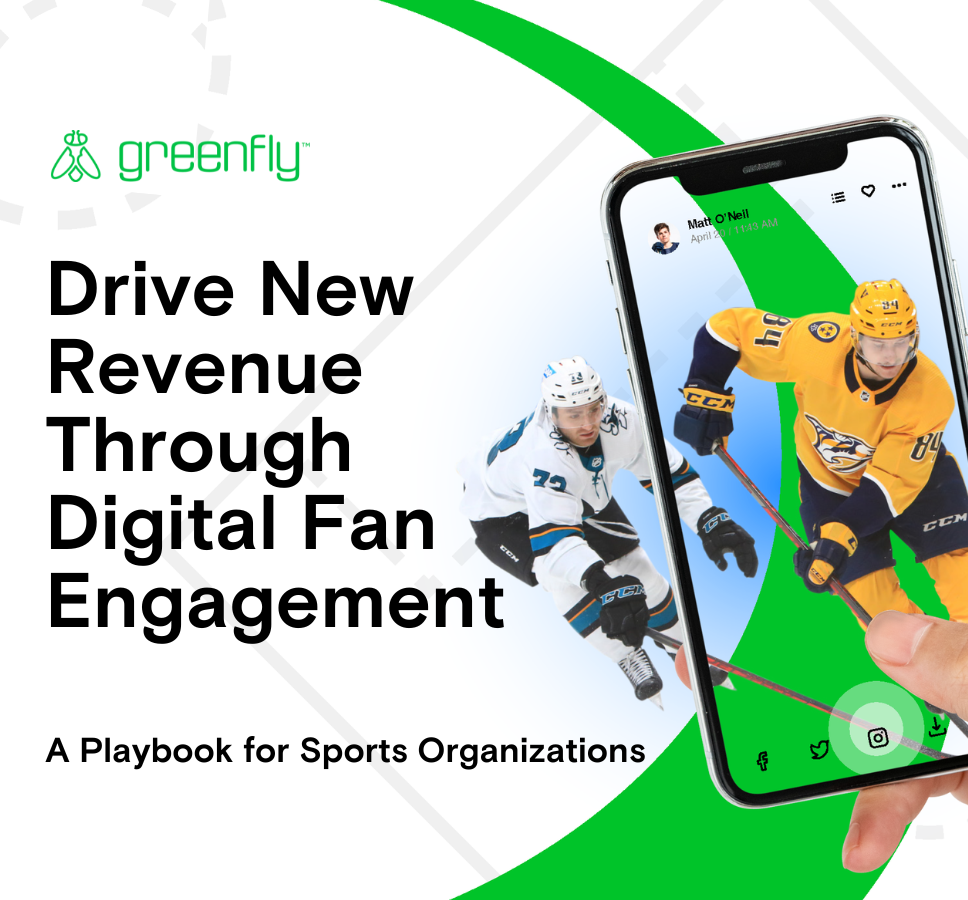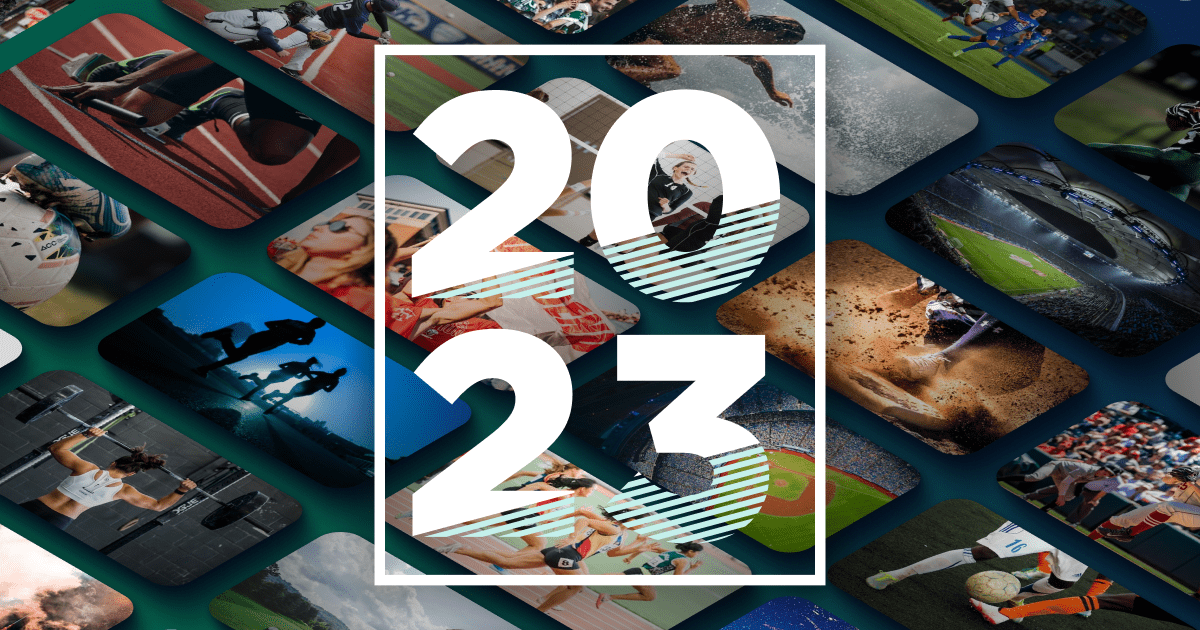As 2022 comes to a close and we round the corner to a new year, every area of the sports industry is becoming more sophisticated in how it approaches fandom and the business of sport. In a year bookended by the most worldwide of events in the Winter Olympics and the FIFA World Cup, fans have become more complex in how and what they digest in their sports content diet. The digital and social media trends in sport for 2023 we see at Greenfly are no exception.
Continuous fan engagement is becoming ever more complex as well. There’s a bounty of options that fans have for entertainment – streaming, SVOD, AVOD, broadcast, cable, satellite, owned mobile apps and, of course, social media. And there are more new alternatives for digital connectivity, tech trends, and social media feeds every week.
Audiences have made it clear what they want from their sports experiences: more choice in how and where they engage and even what that specific content looks like. Individual fans have started to ignore brands on social media. That means they’re now focused on connecting with their favorite athletes — not their favorite team or league.
Meanwhile, sports organizations now consider themselves multichannel media companies delivering more diverse, richer, multi-platform experiences to their audiences.
For future digital trends in sports in 2023, we turned to innovators across the sports landscape. Many shared their thoughts on these topics — and much more — and what they anticipate will be the significant shifts in digital and social media for 2023. They detailed how they think these trends will impact their work and the industry at large.
Many thanks to these experts for their insights! Reach out to us on Twitter @greenfly with your own predictions for how tech trends for the world of sports will further shapeshift in 2023.
2023 Sports Trends and Predictions
Digital Trend #1: Athletes Become the Center of Content
Peter Hutton, Board Member, The Rugby Football League
“In 2023, we will see an increasing awareness among sports organisations of the importance of content distributed and/or created by their athletes and fans. To claim the full value of their sporting IP and to grow the value of their properties, sports organisations will increasingly recognise and quantify the contribution of this wider ecosystem, not just rely on the more traditional means of distribution.”
Adrian D’Arcy, Digital Marketing Manager, World Rugby
“Rugby World Cup 2021 (which took place in 2022) taught us that, increasingly, athletes are making as much of a splash off the field as they are on it. The admiration for Ruby Tui and U.S. hero Ilona Maher has shown that access to personalities is a key entry point for new fans to any sport. That will only grow in 2023.”
Esteban Gonzalez, Digital Content Manager, FIBA 3×3
“With fans looking for more personification and stories, athletes will pivot, even more, to be the center of the content creation for teams and brands. They are our first ambassadors, and fans love to see what they do outside the court and hear their stories, so this is a clear win-win for both athletes and brands.”

Engage Fans and Generate New Revenue
Discover how engaging fans through digital media distribution can directly drive merch, sponsor and broadcaster revenue.
Digital Trend #2: The Value Proposition for Fan Engagement Evolves
Gauthier “Gogo” Rakotonirina, Head of Third Party Marketing, FIBA
“Fans will look for event-based OTT/linear TV sports packages, as opposed to period-based packages. They want to steer away from long-term commitments and would rather pay a premium against a guarantee to see their favourite competitions, without having an extensive knowledge in broadcast rights.”
Burton Lee, Executive Director – Business Operations, Peterborough Petes
“2023 will be the year of the value-add. Fans are ready for the experience evolution and are willing to pay for it (if brands can deliver). Ticket sales? Make them feel like a VIP from driveway-to-driveway. Partnerships? Get sponsors in on the action like never before. Broadcast? Even your grandparents are ready to go beyond the 2nd screen. Revenue and engagement are poised to soar if we can find Goldilocks value for fans.”
Nick Lawson, Co-Founder, SQWAD
“2023 and beyond in sports business and sponsorship will be all about fan segmentation. It’s one thing to build an audience as a team and sell the reach to sponsors; it is a whole different ball game to have pockets of fans based on their interests outside of sports.
For example, how many of your fans watch Food Network or are food enthusiasts? Have you segmented that audience out to deliver them captivating food content that your sponsors can be a part of? Gone are the days of ‘we reach sports fans age X-Y in the city. They are passionate about sports.’ If you really want to drive exceptional value for your sponsors, you need to build segmented audiences that they can tap into beyond the game. You need to tie together their passion for sports and that second segmented passion (food, cars, community, sneakers, etc.).
As my friend Amir Zonozi at Zoomph harps on constantly, Riches are in Niches. Our Niche can no longer be “sports fans”. We must dig deeper into what our fans care about and deliver opportunities that fuse both.”
Esteban Gonzalez, Digital Content Manager, FIBA 3×3
“Fan engagement will continue its own journey in 2023, and companies will need to look even more at what they are offering to their fans. It’s not only about fan engagement anymore; it’s about giving them stories and experiences and keeping your most loyal fans closer to you.”
Justin Karp, Vice President, Social Media, NBC Sports
“The discussion of social platforms as search engines, especially among younger users, will only intensify and become more mainstream – and brands will find innovative ways to improve not only surface engagement but also wider discovery.”
Social Trend #3: All Eyes Are on TikTok — and Monetizing It
Dan Marrazza, Director of Digital Strategy, Pro Football Hall of Fame
“I think one of the largest storylines to watch heading into 2023 is the monetization of TikTok. The platform has evolved so quickly due to having a superior algorithm that consistently serves up content that can be rather addicting. Yet to date, most companies have seen TikTok for pure engagement and brand building, as opposed to being for revenue generation.
Yet at the same time, one of the reasons TikTok probably appeals to so many is that it’s a little less “sale-sy” than other platforms can be. Knowing how making it too sale-sy could take away from what’s made them successful on TikTok, how companies attempt to strike this balance (there will be a lot of trial and error by many companies) to turn these large audiences into consistent revenue is going to be fun to watch.”
Adrian D’Arcy, Digital Marketing Manager, World Rugby
“Short-form content will be king again. The popularity of TikTok, IG Reels and YT shorts will continue to explode. Expect more branded content in this space as businesses try to monetise that reach. Top of funnel advertising will be huge with more advertising spend heading to Tik Tok, a continued focus on converting that interest will go into overdrive.”
Gauthier “Gogo” Rakotonirina, Head of Third Party Marketing, FIBA
“Prediction: TikTok will improve its platform to better convert awareness into sales for brands by redirecting to websites, allowing product tags, and developing an in-platform marketplace. In North America, high school and NCAA athletes will take over the influencer space generating the highest sales return for non-luxury goods and services.”
Digital Trend #4: First-Party Data Becomes a Part of Every Conversation
Jim Hanauer, VP, Fanbase Engineering, Product & Analytics, LEARFIELD
“The dynamics of digital advertising, social media and technology providers will be an extremely important topic to follow in 2023. With the potential of Google deprecating cookies, Elon’s Twitter acquisition, TikTok security concerns, Apple’s controversial 30% cut of all app revenue, Facebook’s big gamble of the metaverse, etc., there feels like a few inflection points that could drastically change the way these technologies are used.
It further emphasizes the critical need for teams and leagues to focus on first-party data collection in order to directly engage with fans and understand their behaviors.”
Matt Gardner, Vice President, Innovation and Digital Strategy, St. Louis Blues
“First-party data collection will continue to become a high priority for sports organizations in 2023 and should be a part of every conversation. At surface-level, it’s converting those millions of followers on social media into a database contact, identifying those watching on TV, and most importantly, knowing the fans coming through the gates at your venue.
The goal is to develop a more digestible data set where you’re segmenting audiences based on their level of fandom — and then deliver an individualized message that carries significant value to each fan based on the insights collected. Are they a season ticket holder? Do they attend games regularly? Are they in-market or out-of-market? What is most important to them about being a fan of your team?
This is not a path that is developed overnight, no matter how quickly emerging tech advances our opportunities. It takes time, a plan, an organizational commitment and patience. The more we can start leveraging individual pieces of data to define an audience and develop an attainable goal that delivers across those key KPIs, the better we can construct content that is meaningful, creates positive sentiment and makes every fan feel seen.”
Brandon Berrio, Director of Football Social Media and Branding, LSU Athletics
“I think the way our three main platforms (Twitter, Facebook and Instagram) distribute content has changed so much that to me, engagement is not something I try to concern myself with as much now compared to previous years. I believe good content that matches our brand and messaging of [head football] Coach [Brian] Kelly will always provide the engagement we want and are looking for. I want to know, though, that our top target audience, recruits, are seeing our content.
We are in the beginning stages of using direct digital marketing to target them as opposed to hoping it reaches their feed or a coach or staff member sending directly. Our first project was for the high school state championship teams in Louisiana and congratulating them through digital marketing instead of billboards in their city or direct messages. It is an interesting way to reach our target audience with information and something we will explore more in 2023.”
Digital Trend #5: Sponsorship Is Influenced by NIL and New Voices
Adeline Nicholson, Social Media Coordinator, Athletes Unlimited
“Through NIL, we are seeing a new wave of athlete sponsorships at the collegiate level that will slowly make its way to the professional stage as these athletes graduate and go pro. In 2023, I predict that athlete sponsorships will become less commercialized (paid posting to promote a brand) and will transition into combining social media campaigns with authentic on-field/court activations.
One example is the Kent State football player [Dante Cephas] having his touchdown celebration sponsored by a local restaurant. When fans see this celebration on TV or at the game, they know they will get a $6 chicken sandwich meal. The athlete and the restaurant promoted this deal on social media, but having the deal be available to anyone watching the game gives both the athlete and the partner a much larger reach than just a social media campaign.”
Dakota Crawford, Marketing Manager, MarketPryce
“I’m looking forward to the continued rise of women athletes in the NIL space in 2023. Just as women’s pro sports continue to grow in popularity, we’ve seen individuals from LSU’s Livvy Dunne, Iowa’s Caitlin Clark and UCLA’s Kiki Rice cashing in on their NIL while women’s team deals at South Carolina and Texas Tech move the needle for brands.
At MarketPryce, we just closed the biggest deal in platform history with a pro women’s hockey player and helped Bella Rasmussen, a high school football player, make national headlines through her long-term NIL partnership with KeyWise AI.
There’s so much momentum, but there’s still so much work to do. Women, as has historically been the case in sport sponsorship, were far outpaced by men in total NIL compensation this year. As leaders across the sports landscape help establish a bigger (and much-deserved platform) for women athletes, a bigger share of the overall NIL conversation should follow.”
J.W. Cannon, Senior Director, Sports Alliances, American Cancer Society
“I think the biggest trend I see happening in 2023 (and beyond) would be the rise of ethical sponsorships. Coming out of the COVID pandemic, we saw brands grow a conscience to a degree, as they realized that standing up for and investing in causes that are important to their customers and employees has become more important to their business than ever. But if it was going to hurt the business, there was a fine line as to how far brands were willing to go in support of causes.
I think we’ll see sponsors take it one step further in 2023. See the example of the 2022 World Cup in Qatar, where the storyline of dead migrant workers and LGBTQ rights did not go away once the games started (a direct contrast to what usually happens with major global events). In fact, we saw many brands build campaigns in support of these human rights issues.
Sponsors are essential revenue streams and marketing strategies for sports properties, and their voice is loud. I believe you’ll not only see more sponsors willing to speak out on these broader societal issues as a part of their partnerships, but also put their money where their mouth is by having a willingness to walk back investments (even to their commercial detriment) in an effort to drive change. Why? A novel concept…because it is the right ethical thing to do.”
Jonathan Kabana, Senior Manager, Digital, Pittsburgh Penguins
“Corporate sponsorship teams will invest even more in digital spaces. With the rise of interest in advertising within video games and the increasingly-accessible world of CTV, sponsorship teams will need to work closer than ever with their digital counterparts.“
Digital Trend #6: AI Drives Digital Content Personalization
Barry Flanigan, Chief Strategy Officer, Aurora Media Worldwide
“Advances in data integration will continue to drive new ways to build interactivity and personalisation into the audience experience for sports content, turning passive viewers into active, engaged fans. Enabling them not only to watch — but to influence — outcomes. With the growth of Web3, this is going to become more prevalent. The ability of Web3 to support membership communities on blockchain presents such an exciting opportunity for creative storytellers, challenging the way we think about personalising content experiences for fans in both the real and the virtual digital world.”
Kyle Sheldon, Founder and CEO, Name & Number
“In 2023, I expect to see a significant increase in soccer-related shoulder programming in the United States. The list of streaming platforms (such as ESPN+, HBO Max, Paramount+, Peacock, and Apple TV, among others) that carry live soccer continues to grow, and both Major League Soccer (on Apple TV) and the U.S. Soccer team (on Turner Sports) are beginning new, long-term TV partnerships. The growing popularity of the women’s game and the National Women’s Soccer League (on CBS and Twitch), along with the 2023 FIFA Women’s World Cup (on FOX and Telemundo), will bring even more eyeballs to the sport.
Expect to see an influx of documentary features, multi-episode doc series, pre- and post-match shows, and a plethora of player-focused content on the digital and social channels of rights holders. In short, 2023 is shaping up to be an exciting year for soccer fans in the U.S.”
Esteban Gonzalez, Digital Content Manager, FIBA 3×3
“With more and more companies moving towards D2C owned platforms, I could see big movements in this sector with Amazon buying more media rights, or TikTok investing more into live content to bring and discover new audiences.”
Daniel Kirschner, President and CEO, Greenfly
“AI will have an incredible impact on our society and change how we work and communicate in many ways, including radically transforming sophisticated knowledge work. But live sports really stand apart in that trajectory.
Sports fans want one-of-a-kind, sensory live experiences that can’t be automated or replicated. That’s why they continue to seek out the core product of sports — the thrill of matches, games, physical contests and in-person moments.
AI can’t replace that level of immersion and excitement, but it can do a lot around the live sports experience to augment it and make it more valuable in context. Those in-person moments can be customized and delivered digitally to more fans around the world with AI-driven personalization, which will meet the demand of younger audiences that love and consume short-form content.”
Reach out to us on Twitter @greenfly with your own crystal ball predictions for the new year!
See our previous predictions from 2022 – how did we do?

